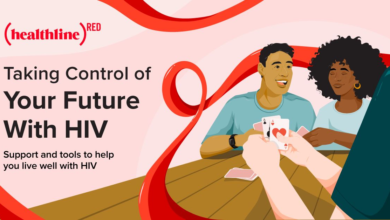11 Tips for Eating Right On the Go with Type 2 Diabetes – Body Health World
[ad_1]
Eating well can feel more difficult when you’re away from home. Here’s how to make it easy.
Eating at home has its advantages, especially if you have type 2 diabetes and need foods that won’t spike your blood sugar. You can easily control what’s in your fridge and then also what you put on your plate.
But eating on the go — and with a super busy schedule — makes for a different story.
To help you make smart choices, whether you’re running around town, rushing from meeting to meeting, going on a road trip, or just don’t have time to stop and sit down for meals, these easy, actionable steps will set you in the direction of success.


Join the free T2D community!
Connect with thousands of members and find support through daily live chats, curated resources, and one-to-one messaging.
Pack your fridge, then plan the day
Even if you’re not eating at home, having fruits, veggies, whole grains, and lean proteins accessible means you can pack yourself a to-go bag of all the essentials.
“Think through your food choices in advance and either package them up to take with you, or put them in one area of the refrigerator so you don’t need to make many food decisions throughout the day,” says Elizabeth DeRobertis, registered dietitian (RD) and certified diabetes educator (CDE) at The Nutrition Center at Scarsdale Medical Group in New York.
Reducing the number of food choices you have to make throughout the day can help you reach for the items that pack nutrients and don’t disrupt your blood sugar levels.
Advertisement
Have protein for breakfast — and every meal
“If you have a busy day ahead, be sure you have a well-balanced breakfast to start your day,” says Lori Zanini, RD, CDE, author of “Diabetes Cookbook and Meal Plan.”
“Having adequate protein in the morning will not only help stabilize blood glucose levels, but research has also shown eating this way can reduce cravings later in the day,” she says.
Plus, protein takes longer to digest than carbs, so it’ll give you a greater sense of fullness, she adds.
DeRobertis suggests eggs in the a.m. (hard-boiled if you’re taking them to-go), or something like egg white bites or an omelet packed with veggies if you can sit down to eat.
Stay hydrated
When you’re packing your food for the day, don’t forget about some low sugar beverages, too.
“Adequate hydration is essential in promoting optimal health, especially when living with diabetes, so I like to recommend filling your water bottle and having it ready to use throughout the day,” Zanini says.
Advertisement
Snack strategically
“Any time someone goes too long without eating, they end up too hungry and often overeat,” DeRobertis says. “That overeating is often what causes high blood sugar.”
That’s why it’s always a good idea to have go-to snacks to turn to when you need a quick bite, and ones you can easily take on the road.
A few items DeRobertis recommends:
- 100-calorie bag of nuts
- a cup of cottage cheese
- string cheese
- 0% Greek yogurt
- veggies with hummus or guacamole
Beef jerky sans nitrates is also a smart option, as it has lots of protein. If you’re not hungry for a snack, though, don’t force it, DeRobertis adds.
Zanini encourages having nuts for a crunchy, satisfying snack as they’re packed with protein and healthy mono- and polyunsaturated fats.
Research also shows that swapping nuts for less wholesome foods like fries or chips can help you control weight in the long-term.
Fill up on a meal or snack at least every 4 to 5 hours, Zanini says.
Check for total carbs
If you’re buying something when you’re out and about, DeRobertis suggests checking the total carb content. For a meal, look for about 30 to 45 grams of total carbs or less. For snacks, aim for about 15 to 20 grams of total carbs.
Most people only look at sugar, DeRobertis says, which is just one piece of the puzzle.
“All carbohydrates eventually turn into sugar when they break down,” she says.
If you’re deciding between two snacks, go for the lower carb one.
Advertisement
Look for some fiber
The one caveat to only checking total carbs: fiber, a nutrient that’s slower to digest so it can keep you full.
If two products have the same amount of total carbs but one has more fiber, go with that one.
The American Diabetes Association says foods with 2.5 grams of fiber are classified as a good source, and those with 5 grams or more are an excellent source, so strive for those numbers.
Picture your plate
When picking your lunch or dinner items, set the goal of filling half your plate with nonstarchy veggies, like leafy greens, bell peppers, or broccoli, says Zanini.
Then split the other half between protein, like grilled fish, poultry, or tofu, and a healthy carb like baked sweet potatoes, quinoa, or black beans.
Advertisement
Make small carb-cutting swaps
Having a sandwich for lunch? Remove the top slice of bread to make it an open-faced sandwich, which cuts out half the carbs, DeRobertis says.
Or, choose lower carb bread, wraps, or even lettuce as the base. At dinner, perhaps try swapping regular rice for cauliflower rice or instead of eating regular pasta go for zucchini noodles or spaghetti squash.
Don’t be afraid to check your blood sugar
About 2 hours after a meal, your blood sugar should be 140 or less, and testing it at this time can help you identify your individual carb tolerance. If you ate a high amount of carbs and your blood sugar spiked, that could signal you need to cut back.
“Once you know this [carb tolerance] number, it can help you make informed choices when you’re on the go,” DeRobertis says.
Advertisement
Check nutrition information
If you have to opt for “fast food” on especially busy days, it’s helpful to educate yourself about nutritional information for quick serve restaurants. Knowing what to choose before you go can help you stick with the better choices offered at that restaurant.
You can view the calories, carbohydrates, sugar, and more in meals from most fast food spots here.
Chat with a professional
A dietitian or diabetes educator can help you plan out and personalize your meal plan, Zanini says.
“Food and timing of meals has a very real impact on blood glucose levels throughout the day, so working with a professional can provide valuable insight into what works best for you,” she says.
Article originally appeared on June 17, 2020 on Bezzy’s sister site, Healthline. Last medically reviewed on June 15, 2020.
[ad_2]



